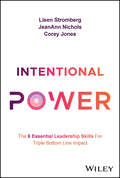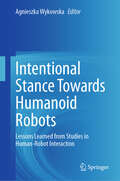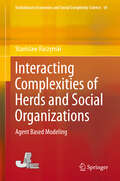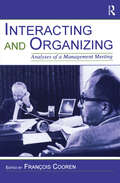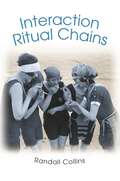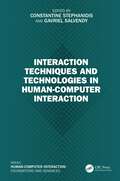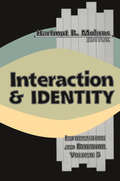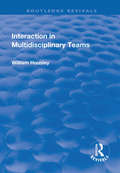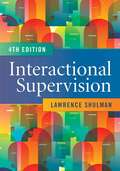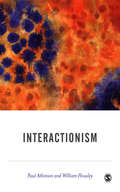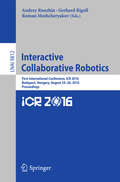- Table View
- List View
Intentional Power: The 6 Essential Leadership Skills for Triple Bottom Line Impact
by Lisen Stromberg JeanAnn Nichols Corey JonesIntentional Power: The 6 Essential Leadership Skills for Triple Bottom Line Impact is THE playbook for modern leaders. Intentional Power: The 6 Essential Leadership Skills for Triple Bottom Line Impact explores how the transition from shareholder capitalism to stakeholder capitalism has created an urgent need for a new model of leadership; a model that enables leaders to navigate competing demands from both internal and external stakeholders including the most racially and age-diverse workforce in history, activist investors, purpose-driven customers, and global government regulators. Intentional Power argues persuasively for a more inclusive, comprehensive approach to leadership disrupting the conventional approach that has been taught for decades in business books, management courses, and by traditional leaders themselves. It is a guide for delivering triple bottom-line impact: enhancing profits, people, and the planet. Written by Lisen Stromberg, JeanAnn Nichols, and Corey Jones, three leadership experts who bring a wealth of experience from their decades of working within companies and alongside leaders as advisors, coaches, and corporate consultants, Intentional Power is a call to action for the next generation of leaders to move beyond an entirely individual focus toward a more sustainable approach to lead and succeed. Deeply researched, the authors draw on an extensive review of the latest literature and insights on leadership development, cognitive and positive psychology, organizational design, and performance management, as well as extensive interviews with leaders across several industries to highlight the most critical skills required by today's executives and managers. They offer a new model of leadership, the HEARTI® model, built on six core competencies: Humility, Empathy, Accountability, Resiliency, Transparency, and Inclusivity. These 6 leadership skills are essential for success in today's new world of work. You'll also find: A comprehensive, inclusive, and effective approach to leading organizations through the rest of the 21st century Examples from leaders across numerous industries who are driving impact for the teams, the companies, and the world at large Practical "How-To's" and actionable Leader Tool Kit activities to help you learn and apply the skills discussed in the book An essential and exciting new resource for next-generation and practicing leaders ready to create profitable companies full of meaning and purpose, Intentional Power is the hands-on leadership guide that founders, entrepreneurs, directors, executives, managers, and impact-driven employees everywhere have been waiting for.
Intentional Stance Towards Humanoid Robots: Lessons Learned from Studies in Human-Robot Interaction
by Agnieszka WykowskaWith the reinassance of Artificial Intelligence (AI) and AI-empowered technologies, such as robots, we are all asking ourselves the question: What role will these new technologies play in our lives and in our society? On the one hand, we are excited about the new opportunities that AI and robots bring. On the other hand, there are understandable fears: What if the AI becomes too powerful? What if the robots become too human-like? This book is centered around a theoretical framework of the Intentional Stance, initially proposed by Daniel Dennett, and addresses the timely question: How do we, humans, approach robots? Do we see them as intentional agents that can potentially become our social companions? Or do we rather approach them as tools, man-made artifacts? What does it take for a robot to make an impression that it is an intentional/social agent? Is it its appearance? Its behaviour? Or, perhaps (and quite likely), the way it interacts with the human? These questions are addressed across various chapters of book, each of which is then complemented by an inspiring conversation with one of the prominent academics and scholars: Daniel Dennett (Philosophy) – the originator of the concept of the Intentional Stance; Hiroshi Ishiguro (Robotics) – the creator of androids, David Gunkel (Robot-Ethics), Bertram Malle (Cognitive Science), Antonio Sgorbissa (Culturally-competent Social Robotics), Bill Vorn (Robotic Art). The book discusses also some important ethical considerations to be made, and risks to be aware of. Do we actually want to create robots that are treated as intentional agents? What if the line between the human/robot categories becomes blurred? As intentional agents, should robots become also moral agents and legal persons in our societal and legal systems?
Inter-Republican Co-operation of the Russian Republic (Routledge Revivals)
by Anwara BegumFirst published in 1997, this book explored Russia’s politics at an important phase in the life of the Russian state. Focusing on the different types of cooperative interactings between Russia and the fourteen other republics of the former Doviet Union from mid 1990-late 91. The book brings out the nature of the Russians effort to reconfigure its ties with these republics. At a time when the Soviet empire with an aim to limit the damage to the interests of the Russians. As the author concludes, Russia’s inter-republican cooperation was a carefully thought-out policy to undermine the Gorbachev government’s effort to control centre-periphery relations and manage the uncontrolled break-up of the Soviet Union. Russia signalled, through its cooperative relations with the republics, that it was willing to accept the republics as sovereign and view its own interaction with them as inter-state relations.
Inter-generational Financial Giving and Inequality
by Karen Rowlingson Ricky Joseph Louise OvertonThis book makes a major contribution to our understanding of 21st Century families in Britain through an exploration of intergenerational relationships. Drawing on new and extensive quantitative and qualitative research, the authors explore the giving and receiving of financial gifts. Despite growing concern about intergenerational tension and even possible conflict, the book finds evidence of a significant degree of intergenerational solidarity both within families at the micro level and between generations more generally within society (at the macro level) in Britain. However, given substantial inequalities within different generations- as a result, in particular, of social class divisions- some families are able to support each other far more than others. This means that strong intergenerational solidarity may lead to the entrenchment of existing intragenerational inequalities. The book will be of interest to scholars and students researching Sociology, Social Policy, Family Sociology, Generations and Intergenerational Relationships.
Inter-group Relations and Migrant Integration in European Cities
by Ferruccio Pastore Irene PonzoThis book presents a comparative analysis of intergroup relations and migrant integration at the neighbourhood level in Europe. Featuring a unique collection of portraits of urban relations between the majority population and immigrant minorities, it examines how relations are structured and evolve in different and increasingly diverse local societies. Inside, readers will find a coordinated set of ethnographic studies conducted in eleven neighbourhoods of five European cities: London, Barcelona, Budapest, Nuremberg, and Turin. The wide-ranging coverage encompasses post-industrial districts struggling to counter decline, vibrant super-diverse areas, and everything in between. Featuring highly contextualised, cross-disciplinary explorations presented within a solid comparative framework, this book considers such questions as: Why does the native-immigrant split become a tense boundary in some neighbourhoods of some European cities but not in others? To what extent are ethnically framed conflicts driven by site-specific factors or instead by broader, exogenous ones? How much does the structure of urban spaces count in fuelling inter-ethnic tensions and what can local policy communities do to prevent this? The answers it provides are based on a multi-layer approach which combines in-depth analysis of intergroup relations with a strong attention towards everyday categorization processes, media representations, and narratives on which local policies are based. Even though the relations between the majority and migrant minorities are a central topic, the volume also offers readers a broader perspective of social and urban transformation in contemporary urban settings. It provides insightful research on migration and urban studies as well as social dynamics that scholars and students around the world will find relevant. In addition, policy makers will find evidence-based and practically relevant lessons for the governance of increasingly diverse and mobile societies.
InterViews: Learning the Craft of Qualitative Research Interviewing
by Steinar Kvale Svend BrinkmannThe Third Edition of Brinkmann and Kvale’s InterViews: Learning the Craft of Qualitative Research Interviewing, offers readers comprehensive and practical insight into the many factors that contribute to successful interviews. The book invites readers on a journey through the landscape of interview research, providing the "hows" and "whys" of research interviewing, and outlines paths for students to follow on the way to research goals. Thoroughly updated to account for all recent developments in qualitative interviewing, the New Edition expands its focus on the practical, epistemological, and ethical issues involved in interviewing, while maintaining the fluid and logical structure it has become known for throughout the text.
Interacting Complexities of Herds and Social Organizations: Agent Based Modeling (Evolutionary Economics and Social Complexity Science #19)
by Stanislaw RaczynskiThis book presents examples of and the latest simulation studies on artificial societies and populations, highlighting innovative implementations of various models of artificial societies and populations using a new, C++-related simulation tool. It demonstrates that the prey-predator models—including spatial distribution, moving patterns, limited renewable food, fear, gregarious (herd) instinct, clustering, epidemics, and competition—are more complex than other publications have suggested, and highlights the great discrepancy between agent-based and conventional continuous models. The book also discusses the modeling and simulation of self-organization and interactions between organizations, including terror organizations, offering fascinating insights into organizational dynamics. The book provides a broad range of examples and comparisons with the classical dynamics approach, showing readers how to construct models of complex systems. It starts with descriptions of the behavior of interacting individuals and also includes important information on the macro-behavior of the whole system.
Interacting and Organizing: Analyses of a Management Meeting (Routledge Communication Series)
by François CoorenThis work provides an exceptional case study, shedding light onto the functioning of an actual corporate board of directors. It presents analysis of a series of corporate management meetings shown in the 1974 documentary film, Corporation: After Mr. Sam. The film chronicles the discussion and communication processes as a company considers how to replace its president, and it serves as a unique opportunity for analysis of real-world organizational discourse. With an impressive list of prominent contributors, Interacting and Organizing: Analyses of a Management Meeting employs the dual perspectives of organizational communication and language and social interaction (LSI) to examine the film. It is arranged around specific topics, analyzed separately by organizational communication and LSI scholars. Editor François Cooren provides an introduction for each topic, and a comparison and synthesis conclude each part. Readers will appreciate the information presented, as it is an arena typically off-limits to outside eyes. The transcript of the film is included as an appendix to the volume. This volume is appropriate for use in advanced courses and seminars in organizational communication, LSI, management, and organizational behavior. With its distinctive approach to studying the film's content, it will be invaluable to scholars, researchers, and graduate students in organizational communication, LSI, and management.
Interaction Effects in Linear and Generalized Linear Models: Examples and Applications Using Stata (Advanced Quantitative Techniques in the Social Sciences #12)
by Robert L. KaufmanOffering a clear set of workable examples with data and explanations, Interaction Effects in Linear and Generalized Linear Models is a comprehensive and accessible text that provides a unified approach to interpreting interaction effects. The book develops the statistical basis for the general principles of interpretive tools and applies them to a variety of examples, introduces the ICALC Toolkit for Stata (downloadable from the Robert L. Kaufman’s website), and offers a series of start-to-finish application examples to show students how to interpret interaction effects for a variety of different techniques of analysis, beginning with OLS regression. The data sets and the Stata code to reproduce the results of the application examples are available online.
Interaction Effects in Linear and Generalized Linear Models: Examples and Applications Using Stata (Advanced Quantitative Techniques in the Social Sciences #12)
by Robert L. KaufmanOffering a clear set of workable examples with data and explanations, Interaction Effects in Linear and Generalized Linear Models is a comprehensive and accessible text that provides a unified approach to interpreting interaction effects. The book develops the statistical basis for the general principles of interpretive tools and applies them to a variety of examples, introduces the ICALC Toolkit for Stata (downloadable from the Robert L. Kaufman’s website), and offers a series of start-to-finish application examples to show students how to interpret interaction effects for a variety of different techniques of analysis, beginning with OLS regression. The data sets and the Stata code to reproduce the results of the application examples are available online.
Interaction Ritual Chains (Princeton Studies in Cultural Sociology #62)
by Randall CollinsSex, smoking, and social stratification are three very different social phenomena. And yet, argues sociologist Randall Collins, they and much else in our social lives are driven by a common force: interaction rituals. Interaction Ritual Chains is a major work of sociological theory that attempts to develop a "radical microsociology." It proposes that successful rituals create symbols of group membership and pump up individuals with emotional energy, while failed rituals drain emotional energy. Each person flows from situation to situation, drawn to those interactions where their cultural capital gives them the best emotional energy payoff. Thinking, too, can be explained by the internalization of conversations within the flow of situations; individual selves are thoroughly and continually social, constructed from the outside in. The first half of Interaction Ritual Chains is based on the classic analyses of Durkheim, Mead, and Goffman and draws on micro-sociological research on conversation, bodily rhythms, emotions, and intellectual creativity. The second half discusses how such activities as sex, smoking, and social stratification are shaped by interaction ritual chains. For example, the book addresses the emotional and symbolic nature of sexual exchanges of all sorts--from hand-holding to masturbation to sexual relationships with prostitutes--while describing the interaction rituals they involve. This book will appeal not only to psychologists, sociologists, and anthropologists, but to those in fields as diverse as human sexuality, religious studies, and literary theory.
Interaction Ritual: Essays in Face-to-Face Behavior
by Erving Goffman"Not then, men and their moments. Rather, moment and their men," writes Erving Goffman in the introduction to his groundbreaking 1967 Interaction Ritual, a study of face-to-face interaction in natural settings, that class of events which occurs during co-presence and by virtue of co-presence. The ultimate behavioral materials are the glances, gestures, positionings, and verbal statements that people continuously feed into situations, whether intended or not.A sociology of occasions is here advocated. Social organization is the central theme, but what is organized is the co-mingling of persons and the temporary interactional enterprises that can arise therefrom. A normatively stabilized structure is at issue, a "social gathering," but this is a shifting entity, necessarily evanescent, created by arrivals and killed by departures. The major section of the book is the essay "Where the Action Is," drawing on Goffman's last major ethnographic project observation of Nevada casinos.Tom Burns says of Goffman's work "The eleven books form a singularly compact body of writing. All his published work was devoted to topics and themes which were closely connected, and the methodology, angles of approach and of course style of writing remained characteristically his own throughout. Interaction Ritual in particular is an interesting account of daily social interaction viewed with a new perspective for the logic of our behavior in such ordinary circumstances as entering a crowded elevator or bus." In his new introduction, Joel Best considers Goffman's work in toto and places Interaction Ritual in that total context as one of Goffman's pivotal works: "His subject matter was unique. In sharp contrast to the natural tendency of many scholars to tackle big, important topics, Goffman was a minimalist, working on a small scale, and concentrating on the most mundane, ordinary social contacts, on everyday life.'"
Interaction Ritual: Essays in Face-to-Face Behavior
by Erving Goffman"Not then, men and their moments. Rather, moment and their men," writes Erving Goffman in the introduction to his groundbreaking 1967 Interaction Ritual, a study of face-to-face interaction in natural settings, that class of events which occurs during co-presence and by virtue of co-presence. The ultimate behavioral materials are the glances, gestures, positionings, and verbal statements that people continuously feed into situations, whether intended or not.A sociology of occasions is here advocated. Social organization is the central theme, but what is organized is the co-mingling of persons and the temporary interactional enterprises that can arise therefrom. A normatively stabilized structure is at issue, a "social gathering," but this is a shifting entity, necessarily evanescent, created by arrivals and killed by departures. The major section of the book is the essay "Where the Action Is," drawing on Goffman's last major ethnographic project observation of Nevada casinos.Tom Burns says of Goffman's work "The eleven books form a singularly compact body of writing. All his published work was devoted to topics and themes which were closely connected, and the methodology, angles of approach and of course style of writing remained characteristically his own throughout. Interaction Ritual in particular is an interesting account of daily social interaction viewed with a new perspective for the logic of our behavior in such ordinary circumstances as entering a crowded elevator or bus." In his new introduction, Joel Best considers Goffman's work in toto and places Interaction Ritual in that total context as one of Goffman's pivotal works: "His subject matter was unique. In sharp contrast to the natural tendency of many scholars to tackle big, important topics, Goffman was a minimalist, working on a small scale, and concentrating on the most mundane, ordinary social contacts, on everyday life.'"
Interaction Techniques and Technologies in Human-Computer Interaction
by Gavriel Salvendy Constantine StephanidisThis book offers a thorough exploration of interaction design by examining various technologies,interaction techniques, styles, and devices.This book• Assists readers in acquiring a deep understanding of diverse ways humans interact withcomputer technologies and in selecting the most suitable approach for various interactivescenarios.• Introduces cutting‑edge interaction techniques, including multimodal and gesture‑basedinteraction, wearables, haptic, speech and sound‑based interaction, embodied interaction,and more.• Advances beyond traditional interfaces to large and multiscreen interactions, proxemics,brain‑computer interfaces, affective computing and Extended Reality.This book will appeal to individuals interested in Human-Computer Interaction research andapplications.
Interaction and Identity
by Harmut B. MokrosScholarly interest in issues of self-identity has exploded across disciplines within the humanities and social sciences in recent years. Common to these concerns are the assumptions that self-identity is not an a priori, not given or fixed, but created in the process of communication. This also assumes that social institutions and values are produced and reproduced by individuals in interaction. To capture the essential characteristics of a person requires analysis of how the social and psychological intersect in moments of communication.Interaction and Identity contributes, theoretically and empirically, to contemporary scholarly interest in issues of identity. Chapters and contributors to this stand alone volume include: "Part/Whole Discovery: Stages of Inquiry" by Thomas Scheff; "Communication" by Gregory Bateson; "Internal Muzak: An Examination of Intrapersonal Relationships" by Linda Lederman; "The Constitution of Identity as Gendered in Psychoanalytic Therapy: Ideology and Interaction" by Margaret Carr; and "The (Reconstruction and Negotiation of Cultural Identities in the Age of Globalization" by Getinet Belay.The multiple disciplines of social research with contemporary interest in identity are ably reflected in Interaction and Identity. The authors are drawn from eight disciplines: anthropology, communication, information science, linguistics, philosophy, psychoanalysis, psychology, and sociology. This book will be invaluable to scholars in all these areas—above all in communication research as such.
Interaction and Player Research in Game Development: 4th International Workshop, WIPlay 2025, Belo Horizonte, Brazil, September 8, 2025, Proceedings (Communications in Computer and Information Science #2623)
by Ticianne Darin Kamila Rios Georgia Cruz Leonardo Tórtoro Diego RiccaThis book constitutes the proceedings of the 4th International Workshop on Interaction and Player Research in Game Development, WIPlay 2025, which took place in Belo Horizonte, Brazil, in September 2025. The 10 full papers and 2 full papers included in this book were carefully reviewed and selected from 15 submissions. They were organized in topical sections as follows: Socially Conscious and inclusive game design; ethical game design and responsible gaming; and practical methods and frameworks for game design and evaluation.
Interaction for Designers: How To Make Things People Love
by Brian L.M BoylInteraction for Designers shows you how to connect a product with its users, whether it’s a simple toaster, a complex ecosystem of intelligent devices, or a single app on your smartphone. This book covers the entire design process so you can start with an idea and carry it through to an engaging final design. It carefully leads you step by step and richly illustrates each stage with examples drawn from business communication, social media and the social economy, consumer electronics, architecture and environments, health care, psychology, art and culture, education, athletics, automotive design, entertainment, fashion, the family home, and a wealth of others. You’ll learn how to brainstorm ideas, research them, explore them, evolve them into finished designs, pitch them, all with the goal of helping you make things that people love. Includes over 200 color images, a glossary, and links to web resources highlighting design concepts and designer interviews. http://interactionfordesigners.com/
Interaction in Multidisciplinary Teams (Routledge Revivals Ser.)
by William HousleyThis title was first published in 2003. In this key volume, William Housley examines the concepts of multidisciplinarity and team practice in social care settings and considers how and why the two concepts have been brought together in recent years. Furthermore, he discusses the various theoretical assumptions that underpin models of multidisciplinary teamwork. This is contrasted with interactional and ethnomethodological approaches that have examined the lived reality of work practices and social organization. The author applies these approaches to understanding multidisciplinary team interaction and communication within social care settings through the use of conversation and membership categorization analysis. Topics covered include the negotiation and accomplishment of professional and lay role-identities, claims making and the display of knowledge in team settings, the use of narrative and stories in decision making and the local organization and accomplishment of team leadership. Furthermore, it is argued that recent developments and ideas concerning the re-engineering of team structures within health and social care settings would benefit from some consideration of observations generated from this approach to exploring multidisciplinary team practice.
Interaction, Communication and Development: Psychological development as a social process (Cultural Dynamics of Social Representation)
by Charis Psaltis Anna ZapitiFor decades there has been considerable interest in the ways that interactions between children can provide a beneficial context for the study of cognitive and social development. In this book Psaltis and Zapiti use both theoretical and empirical research to build on the perspectives of Piaget, Vygotsky, Moscovici, and others including the legacy of Gerard Duveen, to offer a state of the art account of research on the themes of social interaction and cognitive development. Interaction Communication and Development discusses the significance of social identities for social interaction and cognitive development. The empirical set of studies presented and discussed focus on patterns of communication between children as they work together to solve problems. Communications are examined in detail with a focus on: Socio-cognitive conflict, conversational moves and conversation types The way the different forms of the interactions relate to different sources of asymmetry in the classroom The way social representations and social identities of gender are negotiated in the interaction This book provides an important account of how children develop through different kinds of social interactions. It will have considerable appeal for researchers in the fields of developmental psychology, socio-cultural psychology, social representations theory and education who wish to gain a deeper understanding of development and its relation to socio-cultural processes.
Interactional Categorization and Gatekeeping
by Louise TranekjærThis book is about categorization processes in native/non-native workplace interaction, within the context of internship interviews between Danish employers and second language speakers who were born abroad. In this volume, which is one of the first books on gatekeeping, Tranekjær seeks to address processes of power and ideology from a conversation analytical perspective. The book examines the challenges that non-native internship candidates face in processes of employment when employers and job-counsellors seek to conceptualize, categorize and address the candidates' linguistic, ethnic and religious otherness. The book shows how processes of categorization are influenced by broader structures of ideology related to social issues of controversy and debate such as migration, integration and second-language learning. The book also includes an overview of previous gatekeeping studies and proposes a redefinition of the term, which suggests a broader meaning and relevance of the notion.
Interactional Justice: The Role of Emotions in the Performance of Loyalty (Routledge Studies in the Sociology of Emotions)
by Lisa FlowerInteractional Justice explores how defence lawyers accomplish their role in interaction with others and highlights the ways in which they do loyalty work – constructing and conveying loyalty in emotionally and interactionally constraining situations. By drawing on extensive ethnographic fieldnotes and interviews with lawyers, this sociological study brings their loyalty work to life and reveals to the reader the unwritten rules of emotional interactions. It presents how defence lawyers socially construct their duty of loyalty by negotiating informal and implicit professional and social expectations. This accomplishment demands emotion work and face work in order to perform a role which includes defending clients accused of heinous crimes and “losing” the majority of cases. As the defence team is central to this, the ways of doing teamwork are illustrated. Teamwork is also found to be essential between legal professionals to ensure that a criminal trial runs smoothly. All of this takes place within an overarching framework – the emotional regime of law – which aims to uphold the illusionary dichotomy between rationality and emotionality thus quietening the role of emotions. Loyalty and teamwork are features of many professions, workplaces, and aspects of social life making this book an essential tool for understanding strategies for their accomplishment. Focusing on courtroom emotions and interactions, the book suggests how trials can be made more user-friendly and provides guidance for newly qualified legal professionals. The use of ethnographic fieldnotes and interviews provides scholars and students in the social sciences, teaching, law, and medicine with a colourful monograph which reveals and explains emotion and interaction rules. It also makes this book a useful tool for teaching and understanding qualitative research methods.
Interactional Supervision
by Lawrence ShulmanClinical supervision is fraught with difficulties, and those who transition from frontline worker to supervisor often receive little training or support, particularly when it comes to the interpersonal skills needed for implementing complex human relations tasks. Left to their own devices, clinical supervisors must navigate myriad challenges like these real-world examples: <p><p>A supervisor decided that the evaluation process would be a good time to level with a long-term staff member about his inadequate performance. She reviewed the staff member s personnel record and discovered that previous supervisors had given the employee consistently positive and obviously false evaluations. She dreaded the approaching conference, expecting the worker to be angry. <p><p>A supervisor was asked by her administrator to back her up when staff were notified of budget cuts that would result in pay cuts and heavier caseloads. At a team meeting, one worker, who appeared to be speaking for the rest, said to the supervisor, You are going to be with us on this one, aren't you? <p><p>A recently promoted Black supervisor heard that many members of the largely White staff thought he had obtained the promotion because of the agency s affirmative action program. Nothing was said directly; however, he could sense tension in the staff group. He felt angry, hurt, and bitter at the racist element in his reception and increasingly isolated at the agency. <p><p>Drawing on decades of his own experience and the experiences of those he has trained, Lawrence Shulman provides clear, simple models of supervision using a conversational tone and practical advice in this must-have resource. <p><p>Every phase of supervision is discussed in detail, with a focus on communication, making demands for work, facing taboo subjects, and transitioning into and out of roles and relationships. Strategies for group work and meetings include everyday challenges; trauma, such as client deaths; violence against frontline workers; and cutbacks. Supervisors will learn how to apply Shulman s parallel process framework in their interactions with frontline workers to model ideal interactions between workers and their clients. <p><p>In this fourth edition, evidence-based practices and interventions are updated to include the latest ethical and legal aspects of supervision and also feminist; lesbian, gay, bisexual, transgender, queer, and questioning; and trauma-informed practice.
Interactionism (BSA New Horizons in Sociology)
by William Housley Paul Anthony Atkinson'Atkinson and Housley have produced a book that is a very competent, interesting and useful addition to other work in the field. Its distinctive contribution for me, lies in the exploration of the relationship between, and developments within interactionist sociologies' - Sociology What is symbolic interactionism? This refreshing and authoritative book provides readers with: · A guide to the essential thinking, research and concepts in interactionism · A demonstration of the use of the interactionist approach · An explaination of why the interactionist influence has not been fully acknowledged in Britain. The authors argue that few sociologists in Britain have identified themselves with symbolic interactionism, even though many have engaged with interactionist ideas in their research and methodological work. We are all interactionists now, in the sense that many of the key ideas of interactionism have become part of the mainstream of sociological thought. Currently fashionable approaches to sociology display a kind of collective amnesia. A good deal of today's ideas that are presented as 'novel' or 'innovative' only appear so because earlier contributions - interactionism among them - are not explicitly acknowledged.
Interactive Collaborative Robotics
by Andrey Ronzhin Gerhard Rigoll Roman MeshcheryakovThis book constitutes the proceedings of the First International Conference on Interactive Collaborative Robotics, ICR 2016, held in Budapest, Hungary, in August 2016. The 29 papers presented in this volume were carefully reviewed and selected from 48 submissions.
Interactive Collaborative Robotics
by Andrey Ronzhin Gerhard Rigoll Roman MeshcheryakovThis book constitutes the proceedings of the Second International Conference on Interactive Collaborative Robotics, ICR 2017, held in Hatfield, UK, in September 2017, as a satellite event of the 19th International Conference on Speech and Computer, SPECOM 2017. The 30 papers presented in this volume were carefully reviewed and selected from 51 submissions. This new conference invites researchers in the area of social robotics and collaborative robotics to share experience in human-machine interaction research and development of robotic and cyberphysical systems. Topics addressed are: assistive robots, child-robot interaction, collaborative robotics, educational robotics, human-robot interaction, medical robotics, robotic mobility systems, robots at home, robot control and communication, social robotics, as well as safety robot behavior.
